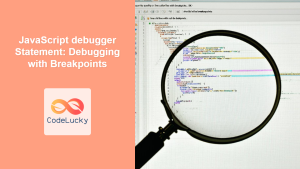In the world of JavaScript programming, control flow is king. One of the most powerful tools in a developer's arsenal for managing control flow is the break statement. This unassuming keyword packs a punch when it comes to terminating loops and switch statements prematurely. In this comprehensive guide, we'll dive deep into the intricacies of the break statement, exploring its various use cases, best practices, and potential pitfalls.
Understanding the Break Statement
The break statement does exactly what its name suggests – it breaks out of a loop or switch statement. When encountered, it immediately terminates the current loop or switch and transfers control to the statement immediately following the terminated statement.
Let's start with a simple example to illustrate this concept:
for (let i = 0; i < 10; i++) {
if (i === 5) {
break;
}
console.log(i);
}
console.log("Loop terminated");
In this example, the loop will print numbers from 0 to 4, and then terminate when i becomes 5. The output will be:
0
1
2
3
4
Loop terminated
🔑 Key Point: The break statement provides a way to exit a loop before its normal completion condition is met.
Break in Different Loop Types
The break statement works in all types of loops in JavaScript. Let's explore how it functions in each:
For Loops
We've already seen an example of break in a for loop. Here's another, more practical example:
const numbers = [1, 2, 3, 4, 5, 6, 7, 8, 9, 10];
let firstEvenNumber;
for (let i = 0; i < numbers.length; i++) {
if (numbers[i] % 2 === 0) {
firstEvenNumber = numbers[i];
break;
}
}
console.log("First even number:", firstEvenNumber);
This code finds the first even number in the array and then exits the loop. The output will be:
First even number: 2
While Loops
The break statement is equally effective in while loops. Here's an example:
let randomNumber = 0;
let attempts = 0;
while (true) {
randomNumber = Math.floor(Math.random() * 10) + 1;
attempts++;
if (randomNumber === 7) {
break;
}
}
console.log(`Found 7 after ${attempts} attempts`);
This code generates random numbers between 1 and 10 until it finds 7, then breaks out of the loop. The number of attempts will vary each time you run the code.
💡 Pro Tip: Using break with an infinite loop (like while (true)) can be a powerful technique when you don't know in advance how many iterations you'll need.
Do…While Loops
The break statement works in do...while loops just as it does in other loop types:
let password = "";
let attempts = 0;
do {
password = prompt("Enter the password:");
attempts++;
if (attempts >= 3) {
console.log("Too many attempts. Access denied.");
break;
}
} while (password !== "secret");
if (password === "secret") {
console.log("Access granted!");
}
This code gives the user three attempts to enter the correct password. If they fail three times, the loop breaks and access is denied.
Break in Nested Loops
When working with nested loops, break only terminates the innermost loop that contains it. Let's look at an example:
const matrix = [
[1, 2, 3],
[4, 5, 6],
[7, 8, 9]
];
let found = false;
for (let i = 0; i < matrix.length; i++) {
for (let j = 0; j < matrix[i].length; j++) {
if (matrix[i][j] === 5) {
console.log(`Found 5 at position [${i}][${j}]`);
found = true;
break;
}
}
if (found) {
break;
}
}
In this example, we're searching for the number 5 in a 2D array. The inner break statement exits only the inner loop, so we need an additional break in the outer loop to completely terminate the search once we've found what we're looking for.
🚫 Common Mistake: Assuming that a break statement will exit all nested loops. Remember, it only exits the innermost loop unless you explicitly break out of each level.
Labeled Break Statements
JavaScript provides a powerful feature called labeled statements, which can be used with break to exit multiple nested loops at once. Here's how it works:
outerLoop: for (let i = 0; i < 5; i++) {
for (let j = 0; j < 5; j++) {
if (i * j >= 6) {
console.log(`Breaking at i = ${i}, j = ${j}`);
break outerLoop;
}
console.log(i, j);
}
}
In this example, the outerLoop label allows us to break out of both loops simultaneously when the condition i * j >= 6 is met. The output will be:
0 0
0 1
0 2
0 3
0 4
1 0
1 1
1 2
1 3
1 4
2 0
2 1
2 2
Breaking at i = 2, j = 3
⚠️ Warning: While labeled breaks can be useful, they can also make code harder to read and maintain if overused. Use them judiciously.
Break in Switch Statements
The break statement is crucial in switch statements to prevent fall-through behavior. Here's an example:
const dayNumber = new Date().getDay();
let dayName;
switch (dayNumber) {
case 0:
dayName = "Sunday";
break;
case 1:
dayName = "Monday";
break;
case 2:
dayName = "Tuesday";
break;
case 3:
dayName = "Wednesday";
break;
case 4:
dayName = "Thursday";
break;
case 5:
dayName = "Friday";
break;
case 6:
dayName = "Saturday";
break;
default:
dayName = "Unknown";
}
console.log(`Today is ${dayName}`);
Without the break statements, execution would "fall through" to the next case, potentially leading to unexpected results.
🔍 Interesting Fact: The fall-through behavior in switch statements can sometimes be useful. For example, you might want multiple cases to execute the same code:
const month = new Date().getMonth();
let season;
switch (month) {
case 11:
case 0:
case 1:
season = "Winter";
break;
case 2:
case 3:
case 4:
season = "Spring";
break;
case 5:
case 6:
case 7:
season = "Summer";
break;
case 8:
case 9:
case 10:
season = "Autumn";
break;
}
console.log(`The current season is ${season}`);
Best Practices and Considerations
When using the break statement, keep these best practices in mind:
-
Use sparingly: While
breakcan be powerful, overuse can lead to code that's hard to understand and maintain. Consider restructuring your logic if you find yourself usingbreakexcessively. -
Document your breaks: When using
breakin complex scenarios, especially with labeled breaks, add comments explaining the logic to help other developers (including your future self) understand the code. -
Consider alternatives: Sometimes, a
breakcan be replaced with a more elegant solution. For example, instead of breaking out of aforloop early, you might be able to adjust the loop's condition. -
Be careful with asynchronous code: The
breakstatement doesn't work with asynchronous loops (likeforEachwith async callbacks). In these cases, you'll need to use other techniques to terminate the loop early. -
Test thoroughly: When using
break, especially in complex nested structures, make sure to test all possible paths through your code to ensure it behaves as expected.
Conclusion
The break statement is a powerful tool in JavaScript, allowing developers to exert fine-grained control over the flow of their programs. Whether you're working with loops or switch statements, break provides a way to exit early when certain conditions are met.
However, like any powerful tool, it should be used judiciously. Overuse of break can lead to code that's difficult to understand and maintain. Always consider whether there might be a more elegant solution before reaching for break.
By mastering the use of break, you'll be better equipped to write efficient, readable JavaScript code that can handle complex control flow scenarios with ease. Happy coding!


















